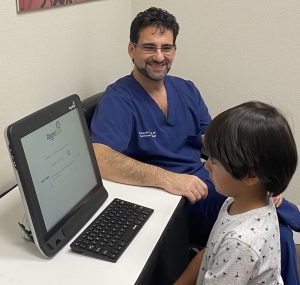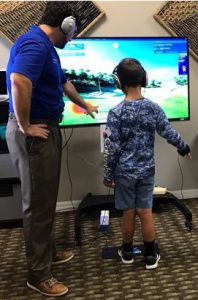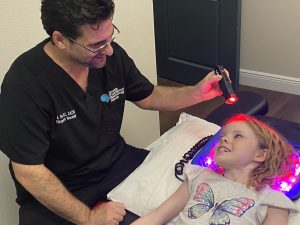The Standard Protocol
I had the opportunity to sit-in with a couple meeting with the head pediatrician of a multi-pediatric physician practice in regards to their 5 year-old son, a typical Disconnected Kid. The child was brought into the pediatrician’s office initially with behavioral issues such as “not applying himself to his work and inattentiveness”. The medical physician’s treatment plan for the past year had consisted solely of “let’s see if he out grows it”. Since the symptoms did not spontaneously resolve after a year, these were the next treatment options available:
- Change schools and repeat the grade

Reading issues may be due to the lack of coordination of the muscles that move the eyes, as well as hold gaze (i.e., not a vision problem). Here, Dr. Frank is utilize the Right Eye system to perform a reading assessment. Find out more here.
- Home School
- Medication, though he felt at that time the child was too young
There is a better way
Learning/behavioral disorders such as Autism, Asperger’s Syndrome, ADHD, and Tourette’s syndrome are physical, neurological conditions involving dysfunction of the brain. Dysfunction does not imply damage or disease, it indicates that certain clusters of cells in your brain are under-functioning and are not as active as they should be. Specifically in children on the Autism spectrum there exists an electrical imbalance in brain stimulation and activity between the right and left hemispheres.
The scientific term for this pandemic of Disconnected Kids is Functional Disconnection Syndrome. The result is a global decrease in brain activity primarily affecting the right hemisphere. This profoundly affects “executive” functions of the brain (planning, decision making, troubleshooting, cognition) performed by the frontal lobe region of the right hemisphere. The symptoms can range from impulsivity and hyper-activity to emotional outbursts (meltdowns) and excessive rough play. Evidence of inappropriate social graces can alienate classmates causing feelings of low self-esteem. As a result of the poor concentration and mental focus, learning becomes a real challenge.

The Interactive Metronome is utilized to resynchronize the regions of the brain, and overall brain/body integration and governance.
Treatment options include Brain-Based Rehabilitation. This therapy is centered around maximizing the child’s brain function, focusing on the specific under-stimulated area of the brain and utilizes specific unilateral (one-sided) sensory/motor modalities. Examples include hemispheric appropriate frequencies of light and sound stimulation, olfactory (smell) stimulation, cross-crawl mechanisms, specific eye movement exercises, vestibular (inner ear) rehabilitation utilizing spins and abrupt changes in head positions, one sided chiropractic adjustments, hemistimulation computer exercise, and balance activities.

Using photobiomodulation (LASER and LED) to improve the integrity and function of tissues.
Help your child reach their maximum potential! Dr. Frank can Help. 352-571-5155
